Japanese Knotweed, also known as Reynoutria japonica (formerly Fallopia japonica, and Polyganum cupsidatum) is a popular plant in the foraging world, but, I didn't find out about it through a wild food book or online group-I read about it in one of my favorite cookbooks: Provence Harvest by Jacques Chibois, as the plant is also known and appreciated by some chefs.
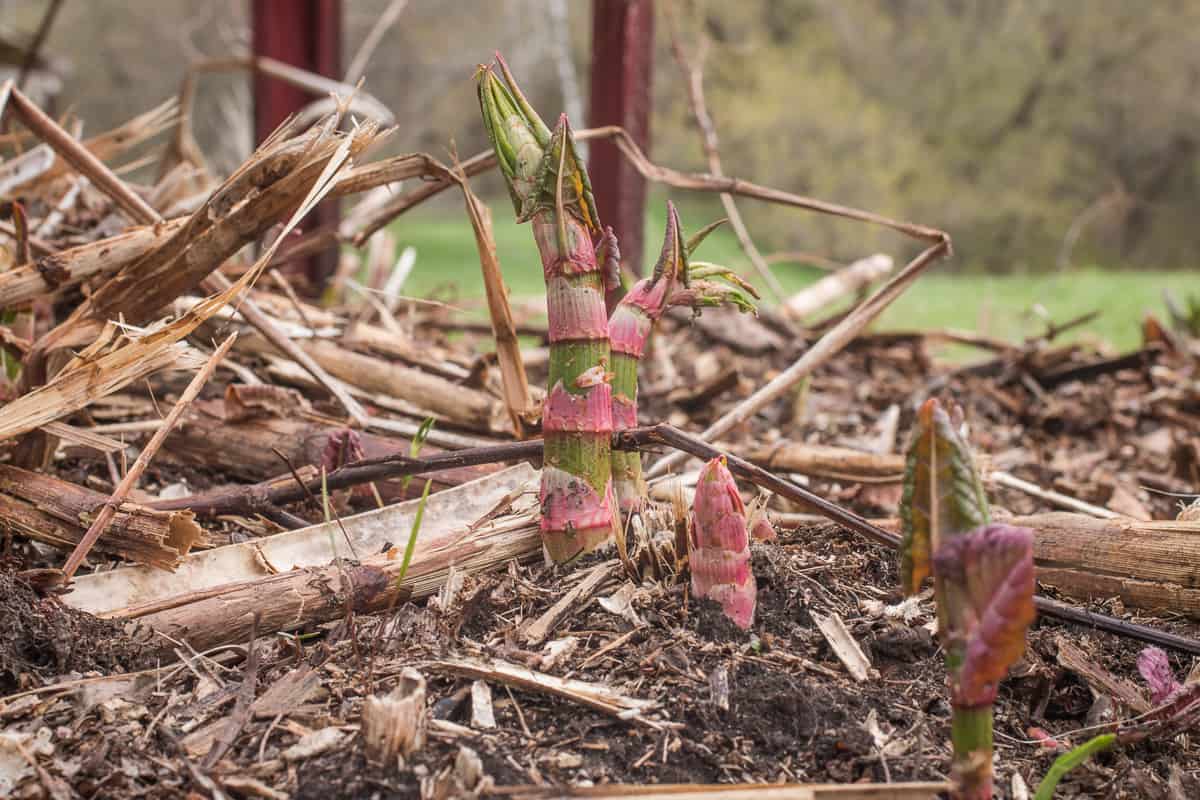
I'm going to share with you what I know about this strange plant that's related both to bamboo and buckwheat, covering some do's and don'ts you should know about harvesting, as well as an explanation of how I cook and prepare it using some of my favorite recipes.
Knotweed is Highly Invasive
Originally, the plant was brought to Europe as an ornamental, and, as is often the case, it spread, rapidly. It's a great plant for pollinators, but don't even think about planting it as an addition to your garden, no matter what someone tells you. Japanese knotweed is one of the most aggressive invasive plants in North America.
This should come as no surprise, as the plant resembles bamboo in its growth, which is also highly invasive and a danger to native species. See my note on caution near the end of the post for more on how to safely handle and dispose of the plant.
Japanese Knotweed Identification
The plant is easy to identify. Here's a few tips to help you.
- Often growing in large, pure stands or thickets like bamboo
- Stems are always hollow and segmented with a blotchy red coloration
- Leaves are triangular to heart-shaped with age
- Small white flowers appear at the end of the season
- Can reach heights of 10-15 feet
- Giant knotweed, a more rare variety, is much larger.
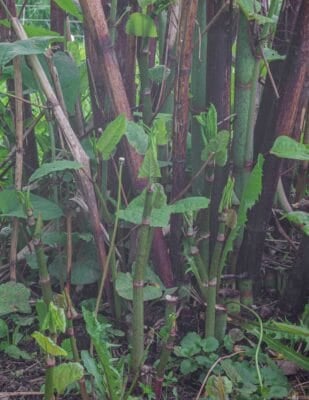

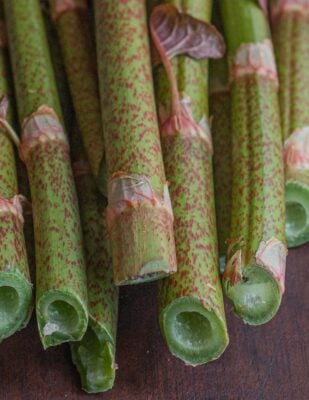
Where to Find Knotweed
If you don't know where any knotweed grows, look in disturbed areas, and places that have been forgotten or aren't tended much, like former gardens or abandoned lots. Just look for the tall, bamboo looking thicket below. I've spotted it in plenty of other places since, from parking lots, to gas stations and roadsides, near railroads, and plenty of other places-many of which can be sprayed by local authorities trying to remove the plant.
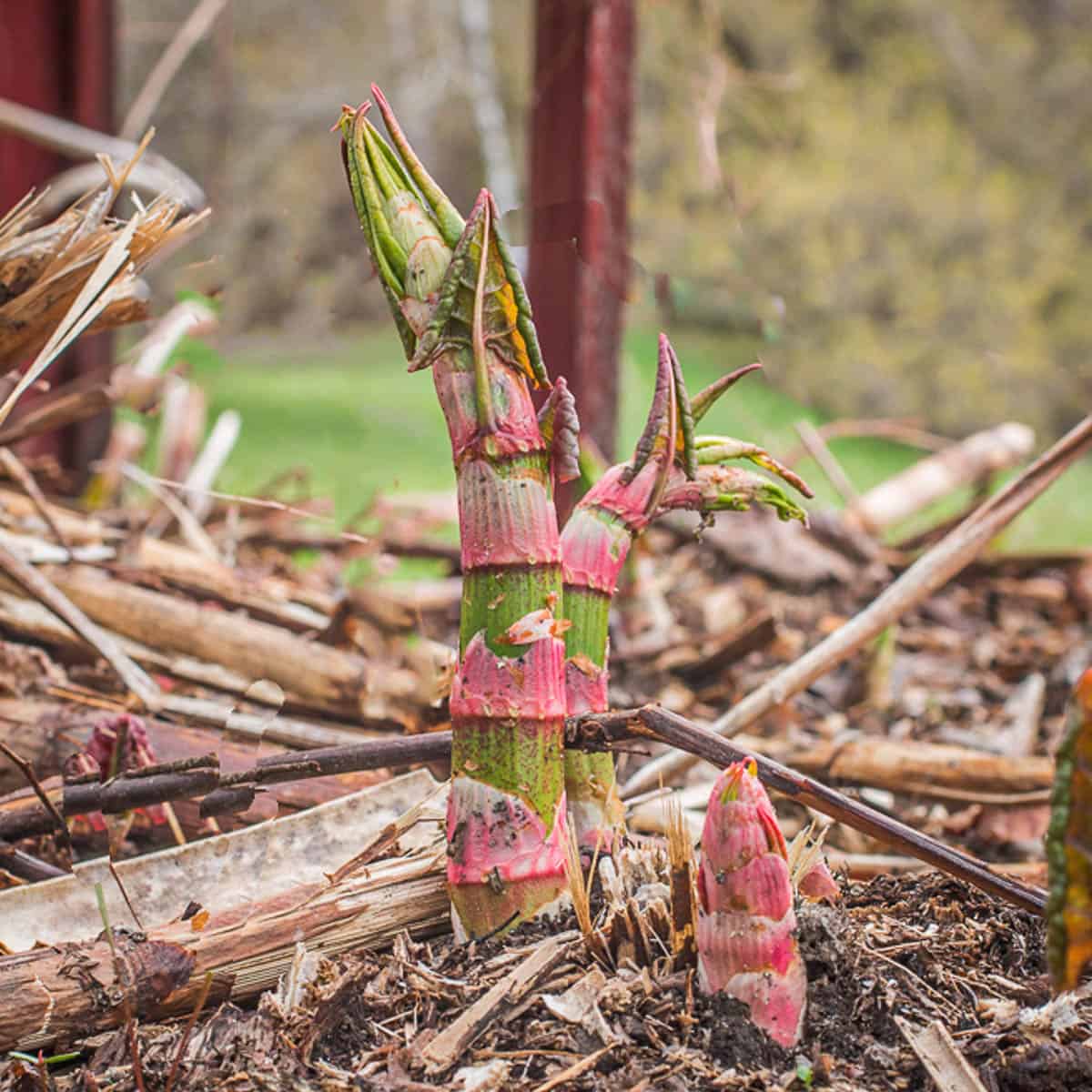
Proceed with Caution
Knotweed is edible, and many people like it, but there's two big points to keep in mind about it from my experience.
- Just because you found a big patch, doesn't mean you should eat it. Park service and state workers regularly spray knotweed colonies with herbicide in my area, especially along roads and railroads. If the plants look at all wilted or sickly, stay away.
- Don't compost your knotweed. Knotweed is related to bamboo, and can regrow like a literal plant zombie if you toss it in your compost. Bake, boil, microwave, incinerate, or otherwise denature any scraps you have from cooking to avoid an infestation in a place you live.
Controlling Japanese Knotweed
If you have knotweed on your property it can be a big problem. I've talked to a number of people who've tried to control the spread. Chemicals are often used, but the plant is really resilient, and no matter what you do, controlling it is going to be a continual process over the course of years.
It Spreads by Seeds and Rhizomes
Knotweed spreads both by seed, and under the ground through its root system. If you look closely at the image below, you can see some young shoots creeping into nearby areas away from the middle of the colony. I would wager the shoots come up in a radius of about 30 feet from the epicenter.
This means that to eradicate the plant, you may have to literally dig up the entire plot of ground. Things can get expensive quick. Below is a relatively small patch someone planted to attract pollinators about 20 years ago. The only way it's been kept in check is by regular mowing during the growing season.
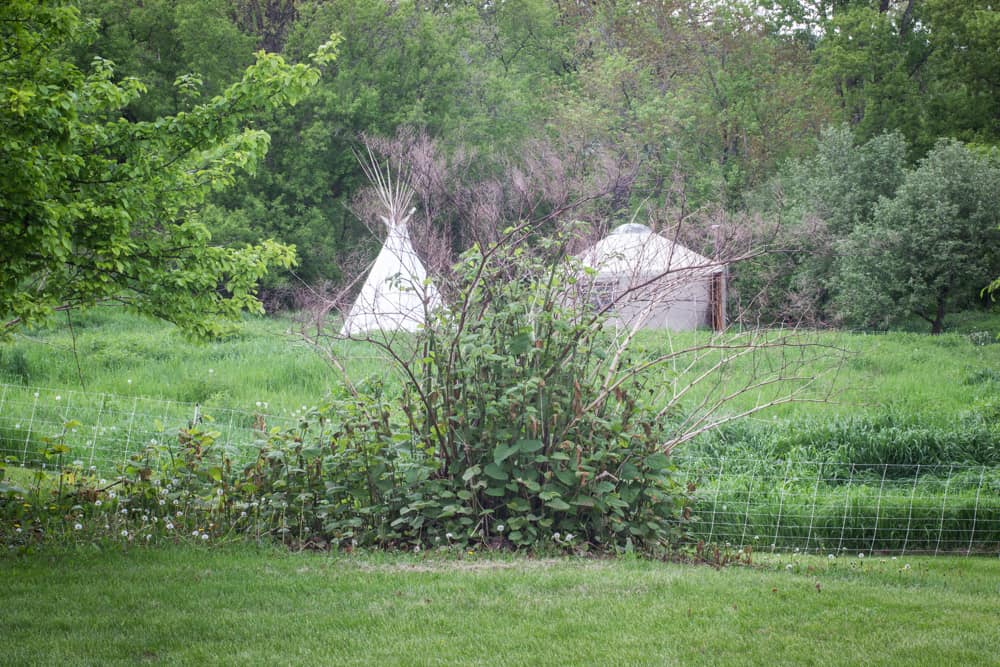
Harvesting Japanese Knotweed
Knotweed grows quickly, and you want to get it young, since it gets very stringy and fibrous as the shoots grow taller. If you come across some and they're already tall and leafy, make sure to look around and inside the network of shoots, there might be younger shoots that are just emerging and tender. Shoots about 1 ft tall or smaller are the best. The larger they are, the less flesh they'll have, and the tougher the skin will be. Leaves should be removed and discarded.
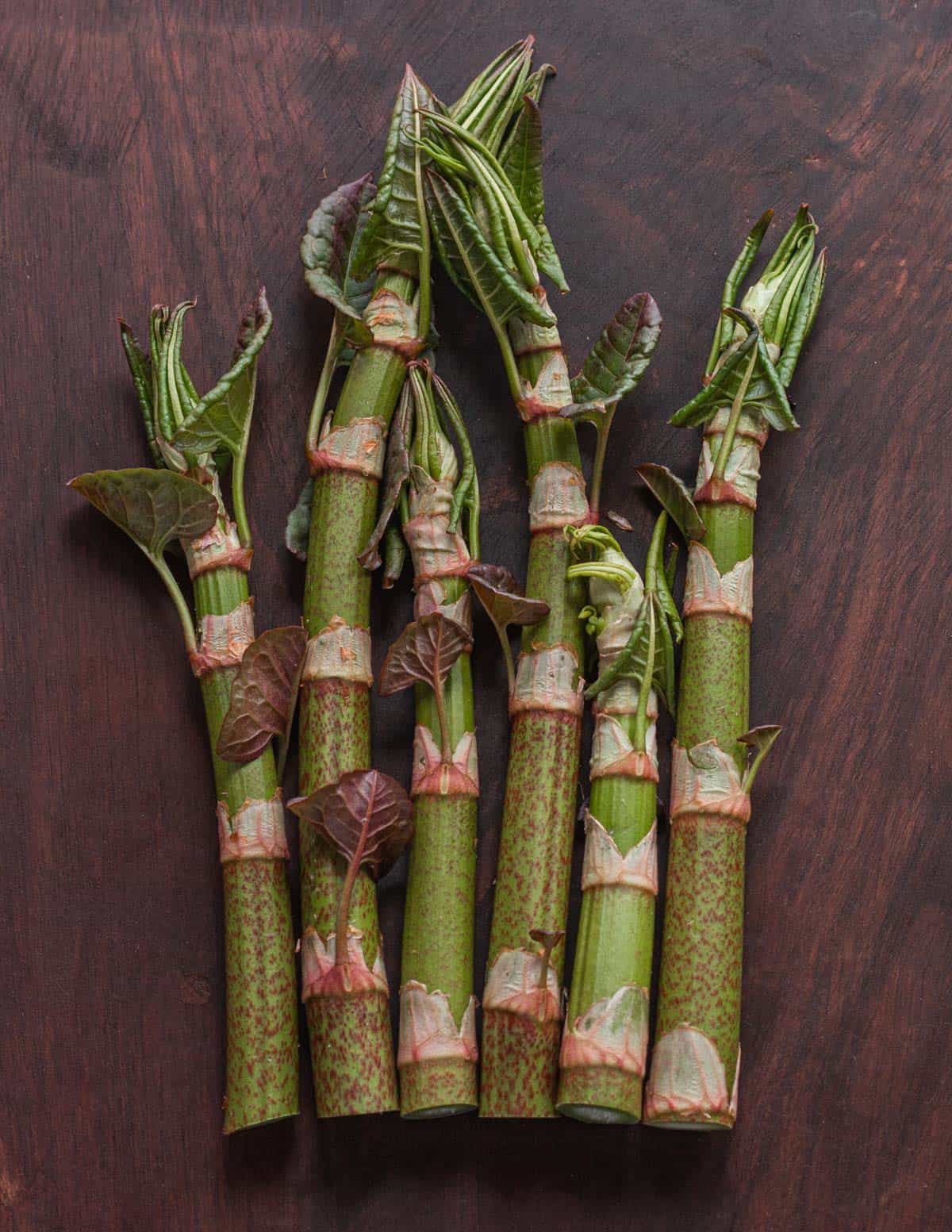
Disposal
After harvesting a bunch of shoots, you're going to have leftover scraps. Do not compost them. Here's what I do. As I'm working with the shoots in the kitchen, I put all of the knotweed peels and scraps into a ceramic bowl. After I'm all done, I microwave the bowl to kill the plant, making sure I don't have to eradicate it from the compost pile at a later date.
Resveratrol and Medicinal Uses of Knotweed
I try to stay away from discussing medicinal aspects of plants and mushrooms here, but I'd be lying if I said I didn't have hope for one particular component of this plant. Resveratrol is a plant compound (a polyphenol) found in a number of things (red wine for example).
The compound is thought to act like antioxidants, and has been used as a folk remedy for a number of ailments, including Lyme disease, which is pretty close to my heart as I'm a Lyme survivor myself. Knotweed is said to have one of the highest concentrations of the compound in any plant we know of. I suggest doing your own research on the topic if you want to know more.
Cooking Japanese Knotweed
Cooking will challenge a lot of people here, especially as it's an acquired taste. There are some things (pickles) that can be very good in the right place though. Here's my advice on cooking with it.
Taste
Japanese knotweed is related to rhubarb, so the first thing you'll notice is a sour tang from it. It tastes vaguely like rhubarb, but with a much more earthy quality that won't appeal to some. Where rhubarb pairs naturally with red, ripe fruits, knotweed is much more at home with fall fruits like apples, pears, and grapes. It's bit hard to describe.
Whenever possible, peel the stems
If the shoots I find aren't thick enough to peel, I'm probably not going to harvest them. The outer skin of the shoots has a stronger flavor than the inside, and will be stringy if the plants are older. For the best results here, you'll want a Kuhn Rikon peeler. Kuhns are a chef standard, and they're cheap-get a three pack and thank me later.
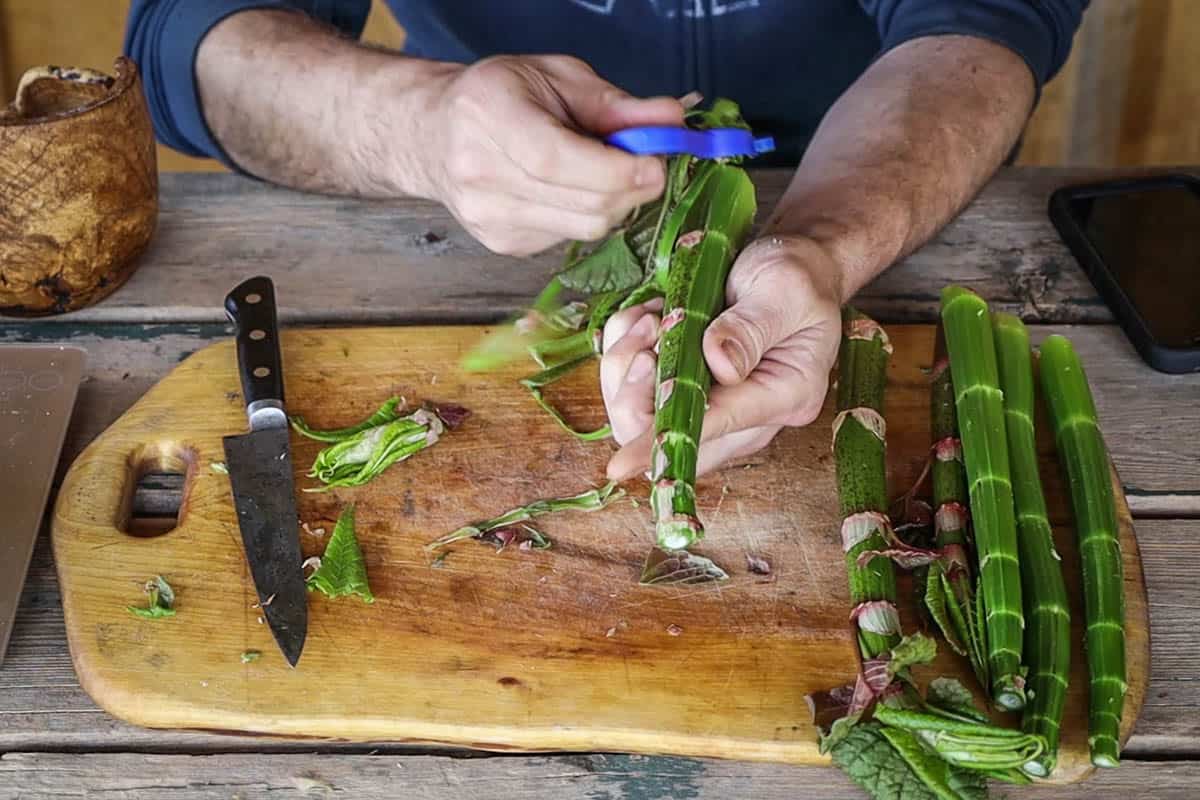
Knotweed Leaves
A lot of people ask me if I eat the leaves of the plant, and the answer is no. The leaves have an even stronger flavor than the stems, as well as being fibrous, so I always remove them before cooking. Don't feel bad about disposing of them.
Mucilage
Besides the flavor, this also turns a lot people off. As the shoots cook, or even if they're exposed to water, they turn slimy, quick. Cooking mellows the slime, but the texture of the hollow stems is, not pleasant, at least for me.
The stems disintegrate during cooking like rhubarb, but with a stringy texture that can be unpleasant, especially if the stems are older. Peeling the stems if at all possible to remove stringy fibers.
Pickling/Fermenting Knotweed
A reader tipped me off to fermenting knotweed, and it's since become my favorite thing to do with the best thick, green shoots. It's the best way to prevent the plant from getting slimy that I've found yet, and the best savory application.
If it's your first time working with the plant, skip down to the fermented knotweed pickles below and try those first.
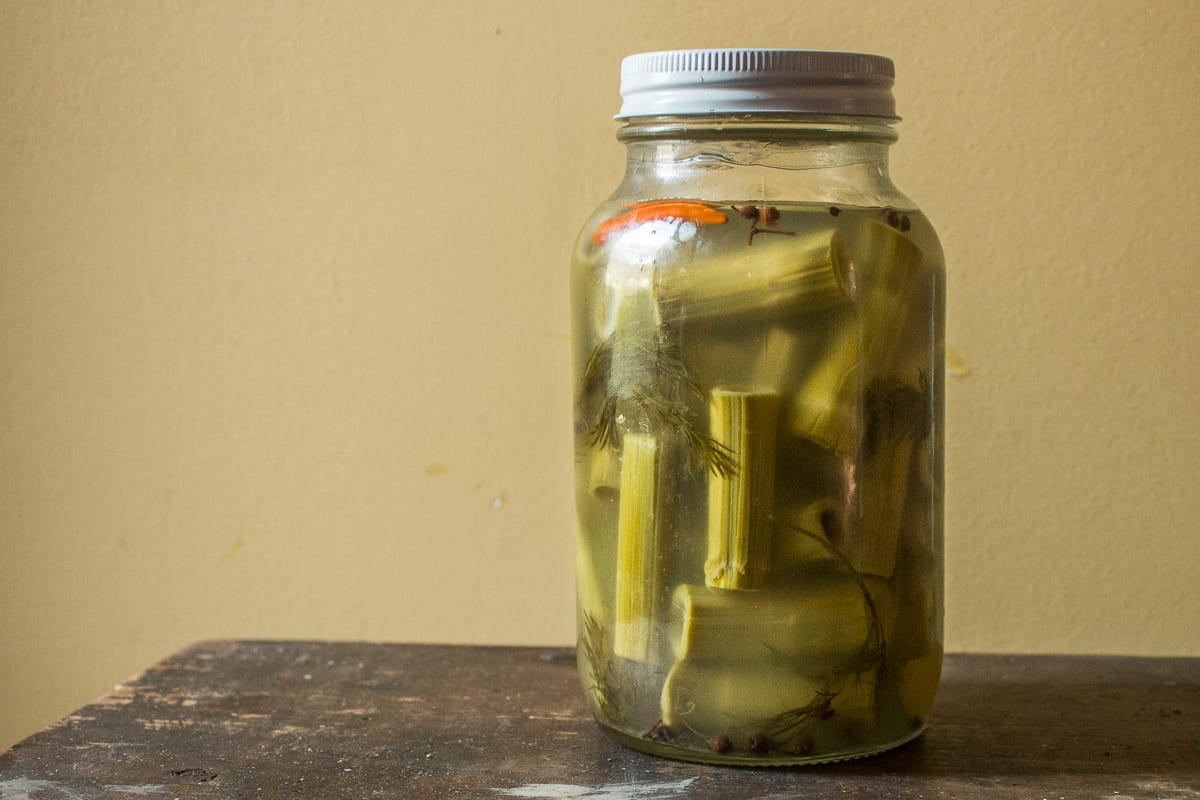
Knotweed Puree
When I harvested large amounts of shoots for my restaurants, I would have my pastry chef cook them down and make a smooth, lightly sweetened puree.

Like the paw-paw, which also has a funky texture after removing the seeds, making knotweed into a puree opens the door to possibilities, as well as bypassing the slimy, flaccid texture of the cooked shoot.
After the puree is made, I freeze it, to make a something with the knotweed I just pull some of the puree out of the freezer and fold it into things-banana bread for example.
Savory
I don't like knotweed as a vegetable unless it's very young and firm, and even then, It's probably going to be the fermented shoots mixed with other things, as in the relish on the trout below.
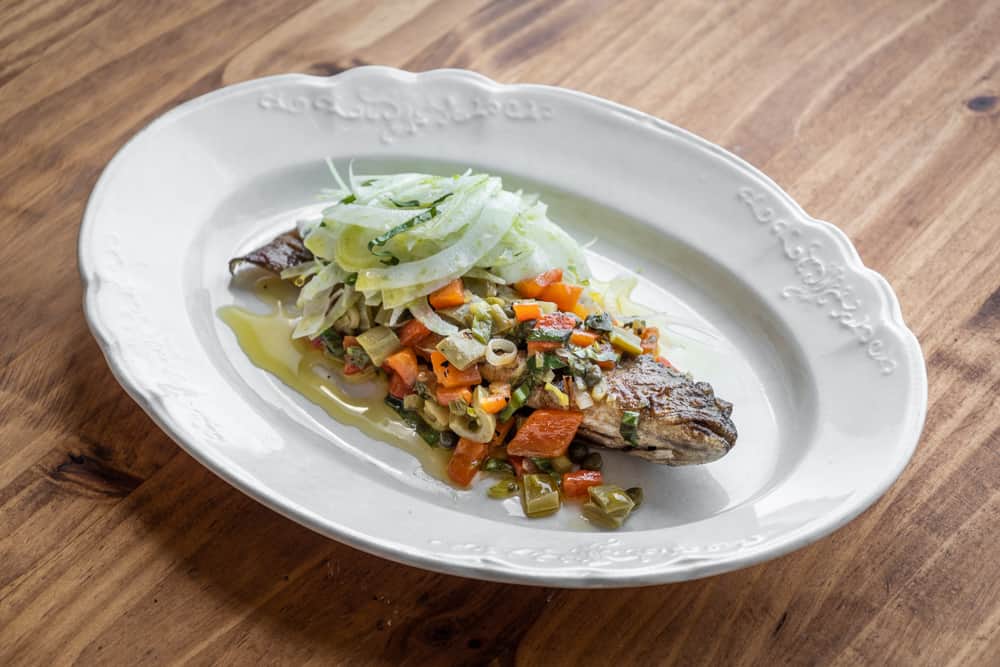
Use in Desserts
Sweet things are probably the easiest for most people to enjoy. As I mentioned, it pairs great with pears and apples. Other friends of knotweed are refreshing herbs like cilantro, lemon balm, spearmint or peppermint. It's also good with cream and dairy, as well as warm spices, which round out it's flavor.
Japanese Knotweed Recipes
This is can be a difficult plant to cook with, but I've come up with some handy ways to use it over the years. I've heard of a swamp-green knotweed tea boiled for hours and taken for medicinal effects, but personally I prefer it as a vegetable, or lightly sweetened.
Japanese Knotweed Pickles (Lacto-fermented)
My favorite savory application for the young shoots. You'll need fat, thick stalks you can peel.

Japanese Knotweed Sorbet
Sorbet is my favorite thing to make with a puree of the stems. If you can peel them, it will be better for it.
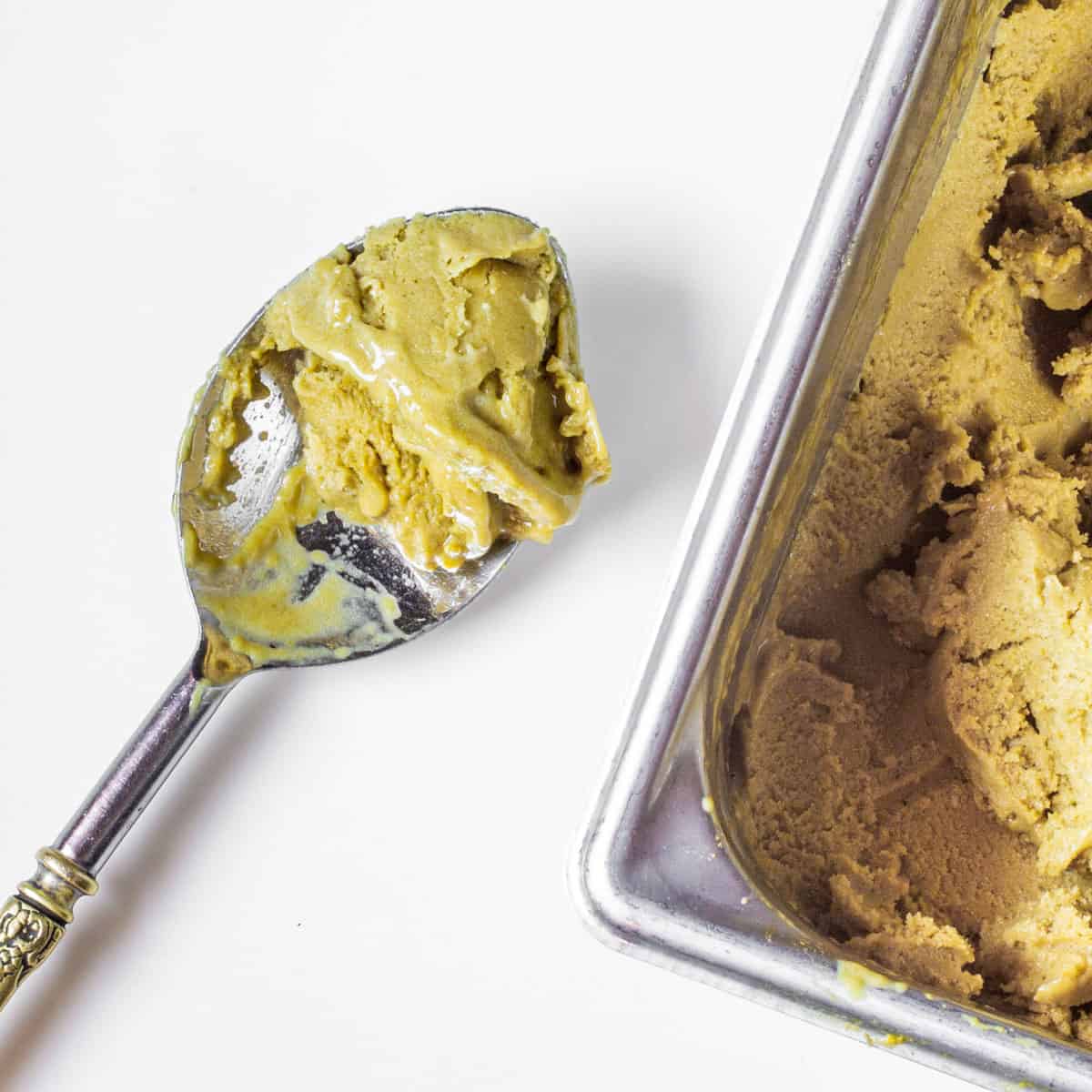
Knotweed Mousse
A simple, easy dessert made from knotweed puree and wild mint.
Mousse Cake
If you really love knotweed, you can try your hand at a jelly roll cake using the mousse above. It's frosted with maple buttercream, herbs and flowers.
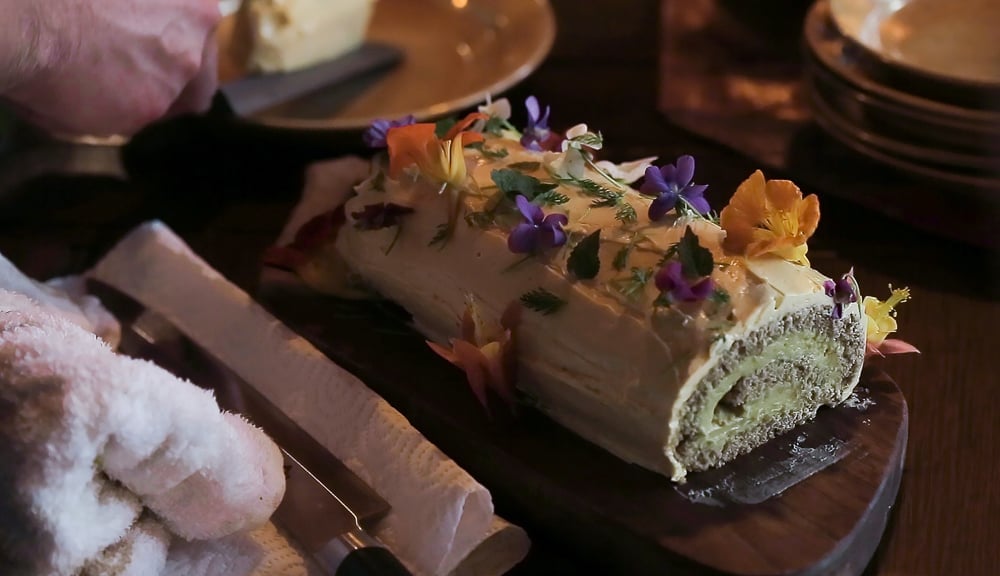
Knotweed Fruit Leather
Fruit leather is probably the easiest and most palatable thing you can make with the shoots. And if they're young, you don't need to peel them. I combine them with apples, cook, puree and dehydrate to make green fruit leather. It's surprisingly good.
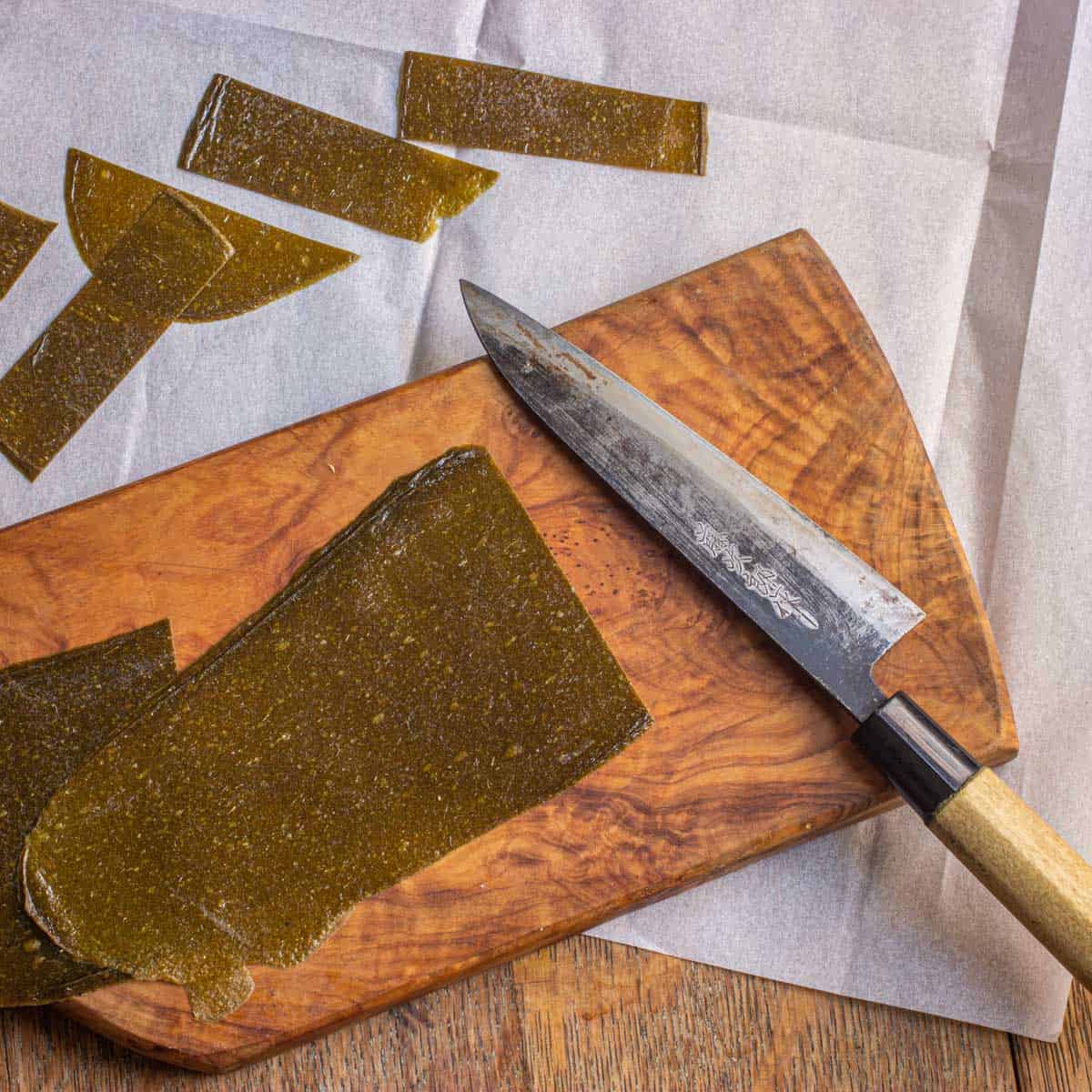

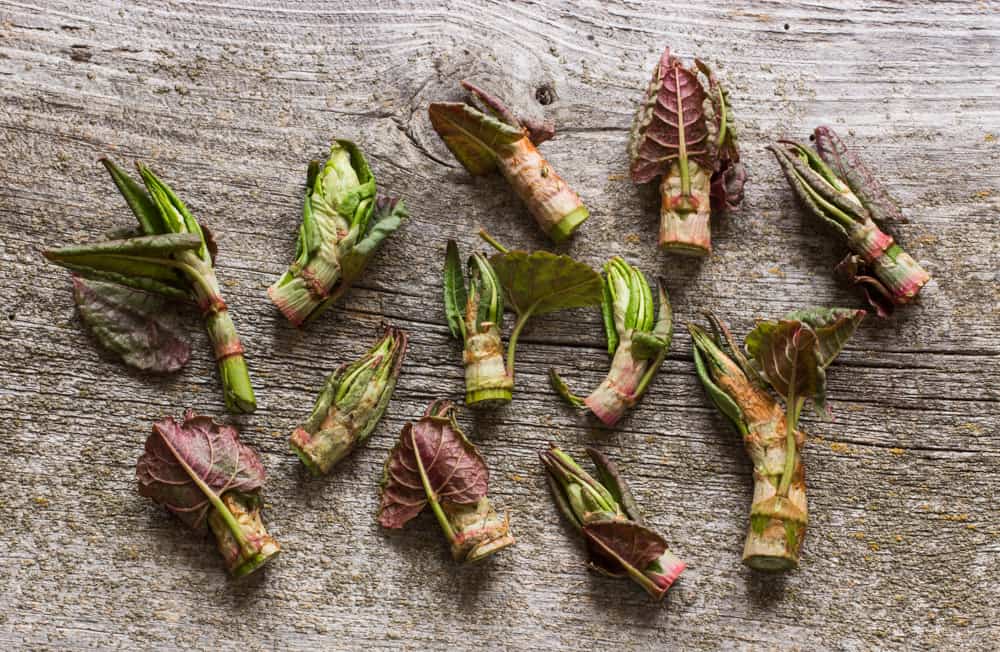
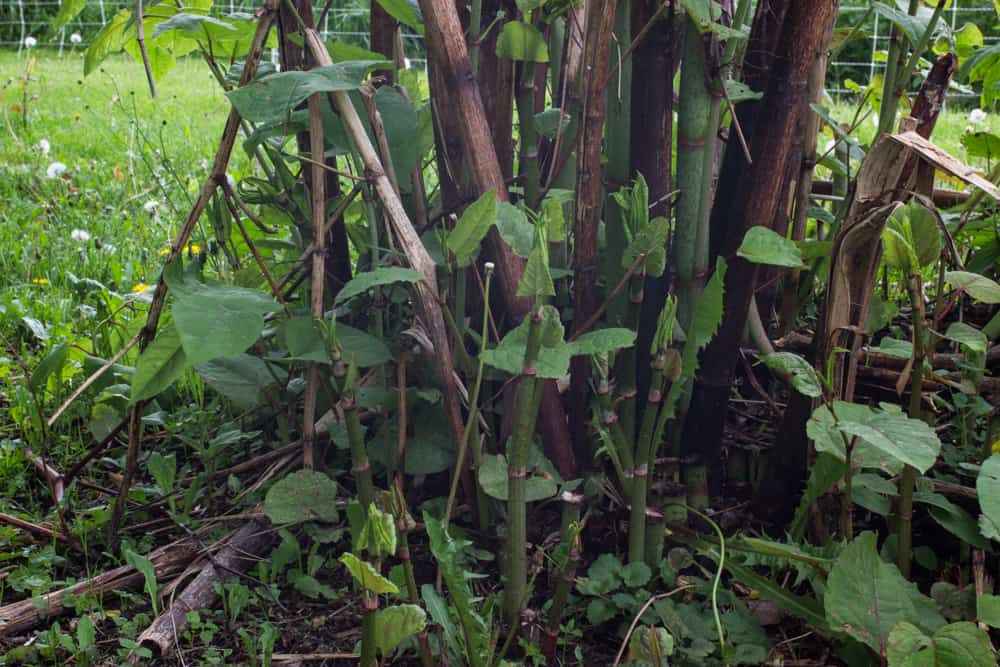

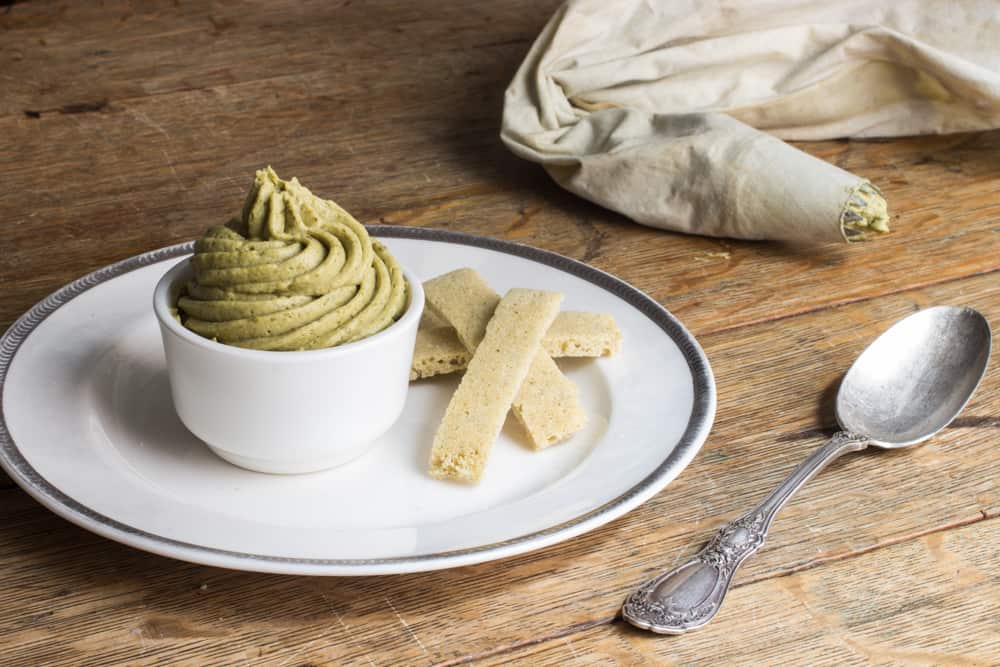
Ken
In this time of corona virus, this plant is a gift from God. The tincture made from Japanese Knotweed rhizomes is excellent for quelling inflammation (cytokine storms) in the lungs and other parts of the body. Lyme sufferers have utilized this for their uncontrolled inflammation and it's excellent for the lung inflammation of today's Covid19 patients.
Alan Bergo
Now if only conventional medicine would wake up to the power of plants.
Carla Beaudet
Oh, they have. but the pharmaceutical corporations can't make money off something you can grow in your yard. There is certainly academic value in isolating compounds and in the in vitro, animal, and human clinical trials, and a lot is learned, in the process but if the plant alone does as well as, if not better than the isolated compounds, they're not going to tell you that. Instead, they're going to tell you that the quantities of the compounds are uncertain in the plants (which is true) and you need to take the controlled dose in the pill, which is less true, considering that the isolated and concentrated compound is MUCH more likely to be dangerous than the concentration of the same compound found in the plant, which is why doses of pharmaceuticals have to be so carefully regulated. I realize that one cannot make the aforesaid generalization for all plant-inspired pharmaceutical compounds, but my research has shown it to be the case for more than one.
Louis Vogel
How do you prepare your tincture ?
Ken
I purchased the tincture already made from places like Great Cape herbs, Sage Women Herbs, etc. Let them do it right. But Stephen Buhner, one of the experts in herbs for Lyme, mentions a method on his website:
http://buhnerhealinglyme.com/basics/extracting-resveratrol/
I'm sure there are other sites that explain the process, as well.
Choice of God
If you plant this in a flower vase/plastic on a cement floor in your property, will it break through the concrete and become invasive?
Alan Bergo
You can try, but if it starts to spread you'll need to eradicate it. It won't break concrete.
Jennifer
Pleas call it what it is- I am extremely allergic to it! It’s used in supplements like resveratol instead of expensive grape skins. I almost had to go to the ER- my throat and lips swelled up!
Sarah W.
Yes! Thank you so much for this. I had been scrolling around looking for knotweed recipes. I made this puree (although my stalks ended up being a bit tall and woody (even after some peeling) so I strained the puree. it's fantastic! I would actively seek this out and make it again. Thank you so much! 🙂
Alan Bergo
It's a great way to preserve knotweed. Good for making quickbreads too!
ann
Knotweed was dropped into one of my garden boxes about 4 years ago, I find uses for it at every growth stage. When I gets bigger I garnish or line plates with the leaves.When it gets tall and sturdy I use it as strengthening poles for climbing plants like tomatoes or peppers. When it's medium height I work it into flower arrangements. It is truly a plant that keeps giving all through the growing season!
Louis
Can the new Springtime re 'bumps' (about 3/4 inch) be used ?
If so, what do you recommend ?
Alan Bergo
Yes they can--they're the best when young. At that stage, they may be firm and not hollow yet. I suggest slicing them into 1/4 inch coins, a little lemon, salt, pepper and olive oil, maybe some fresh herbs. Have the salad raw with some fish poultry.
Jan Hermans
Knotweed is very invasive and can be dormant for over 2 years in a dried state. You should never compost any part of the plant. It spreads like bamboo. It can be burned or barries 4 feet under the ground. The best place to find information about containing it is when you google information from England. They have taken drastic measures there to limit its spread. Properties values drop and in some cases can not be sold until the knotweed has been eliminated. Tinctures for the root are used as a tincture to help support individuals with Lyme Disease. Information on knotweed used in Lymes can be found in “Healing Lyme” by Stephen Harrod Buchner. Some of the same supports needed for Lyme are also now needed to help support individuals with the Corona virus. It’s one of those good/bad plants. Should never plant it but wild harvest and be very responsible in disposing of left over plant material. I place a tarp under my table when harvesting and burn the plant material in my grill to make sure none of it escapes.
Ellen Zachos
Cleaning out the freezer this week, so I made 4 pints of purée and canned it as if it were rhubarb. I have more shelf space than freezer space. The flavor is very promising, thank you!
Pam
How do you discard or use the leaves?
Alan Bergo
Discard the leaves, they're not pleasant to eat.
Laurie
I’ve collected knotweed, cooked, and puréed it. I sweetened it with a little maple syrup and just enjoyed eating it out of the container, because I couldn’t think what else to do with it.
I really appreciate all the ideas here in Allan’s work and in the comments. But here’s the question I want to ask anyone who would serve it to others: how do you get over the gross puke green color? It’s the strangest color of a fruit or vegetable I’ve ever seen. Just a really unappetizing grey-green. That doesn’t bother aanyone?
Alan Bergo
The color is part of the plant, it is not the most attractive, but it is what it is. Hide the color for unsuspecting diners by combining with colorful ingredients. Red rhubarb is the most obvious partner. Did you take a look at the jelly roll recipe?
Jacqui
I used it in strawberry jam and in raspberry jam as one would use rhubarb. In my chutney the colour is hidden by the brown sugar, tamarind and spices. In the fish cakes it's not a problem. Indeed, in savoury dishes this is altogether less of a problem. Because yes ... a knotweed tarte is a rather unattractive creation on its own... though slicing a few fresh strawberries on top goes a long way towards making it appealing and just a few raspberries will brighten up the colour..
Ellen
I haven't cooked with it, but since I have ID'ed it in my garden, I pull it up but leave a little growing so that I can take the tender tips, and I wash it, then put it in my smoothie.
I've read that it has a great amount of Resveretol !
Alan Bergo
Be careful with it. There are a lot of things you could put in your smoothie, use caution with allowing japanese knotweed to grow. It is the most aggressive plant I've ever seen.
Dan
I know of an area off of Hwy 61 going into St Paul where the county a few years ago covered a growth of it with heavy layers of thick carpet. The printed and laminated sign that they left to inform people of what they were doing to "eradicate" this invasive plant was all but faded and shredded from the seasons, yet the knotweed was rising happily from that thick bed of carpet.
A.L. Butler
This came up (via bird droppings?) in one of my box gardens, next to a rhubarb patch interestingly enough. This year I'm going to let some of it go to flower. Interesting article about knotweed: https://www.organicfacts.net/health-benefits/herbs-and-spices/japanese-knotweed.html
Alan Bergo
Bird droppings! I would not let it go to flower unless you are prepared for it to take over your yard. This is a horribly invasive plant.
Dan
Just whipped up my first batch of puree from sprouts of knotweed that I discovered last summer. I think "rhubarb with an earthy edge" describes it nicely. Not sure yet what I will do with it, but I really wanted to see what its all about.
Jacqui
Knotweed just started here, so I imagine it will be up in a few weeks in the mid-west. I just made lacto-fermented knotweed stalk pickles from this recipe more or less . They are FANTASTIC. Better than my dad's cucumber dill pickles (hard to believe though that may be...). And I am embarking on my first batch of chutney this evening - the stalk pieces have been brined overnight and I'm about to start cutting onions. I notice that your recipes are mainly sweet Alan but salty makes a nice change. The pickles are amazing.
Alan Bergo
I admit that I've had trouble enjoying knotweed on the savory side, and have usually cooked it with half it's weight in apple to cut it, since the flavor has been hard for guests to like. I haven't tried pickling it, it might be a good idea to try some pickles this year, since I have access to a ton of it. Thanks for the heads up,, you had me at -better than cucumber dills-, I appreciate it.
Jacqui
The chutney is good too. I cooked lots of onions in vinegar and brown sugar with a big scoop of tamarind paste, ginger, mustard, fenugreek and cumin seeds, a few cloves, some powdered cardamom and coriander, then added the drained brined knotweed and let it cook together for about half and hour. Apple might have been a good addition, for the texture above all, but it is NOT apple season...
But seriously, knotweed stalks stuffed with ground fish accented with combava leaves, lemon grass and fish sauce is really good (if way too much trouble for me, a non-professional cook - stuffing paste into tubes is not one of my superpowers and I will never do it again... but I might if I worked in "one of those restaurants" (if I worked in "one of those restaurants" I would probably have figured out the mysteries behind stuffing paste into tubes.)
Jacqui
Hi Alan,
OK, now I have done it so I can recommend with confidence.
Last night I made fish cakes, baked in ramekins on a bed of knotweed and really, seriously you should try this because it's a fabulous way to use knotweed. The acidity and moisture compliment the fish perfectly.
Here is what I did:
food process 1/2 pound of fish (I used left over bbqed black seabream and makerel but this would work perfectly with anything, cooked or raw)
one egg
1/4 cup bread crumbs
3/4 cup cream (30% because that is what I can get here - well actually, it was a mix of milk and cream because I had an almost empty bottle of milk. I think you would need less liquid if using raw than previously bbqed fish...)
one chopped onion (I put in half raw and half that I had fried in olive oil)
a handful of parsley (I also added cow parsley (Anthriscus sylvestris) because it is the season. Coriander would also be good or ramps ... (I did not add garlic but one could))
a stalk of lemon grass, minced
some slivered combava leaves
enough fish sauce to make it interesting
Chop knotweed stems (peeled if necessary) and put some into the bottom of muffin cups/ramekins (1/4 filled)
Spoon the fish mix around and over the knotweed stems and bake at 350°F until done.
One could also add the chopped knotweed to the mix. I did it this way because I wanted to make some fish cakes with and some without knotweed but everybody (see below) agreed they were better with...
My teenagers who sometimes feel that my culinary experiments with wild plants verge towards the overenthusiastic and absurd (like ... "are all the fuzzy bitter things in the salad really necessary, mom??") thought they were excellent.
Alan Bergo
Jacqui, I can't imagine serving wild food to teenagers, good on you for that. And for the record, yes all the fuzzy and bitter things are necessary, and you'll eventually love them. I'll have to try pickling and cooking in a little fish cake or croquette like you suggest, the knotweed is just barely poking it's head above ground at the farm.
Jacqui
Hi Alan,
let me know what you think about them if you make the fish cakes. You could also try a variation on Hor Mok Pla, with coconut milk and red curry ... but I didn't try that...
I have raised my kids on road kill and wild plants. My 18 year old son (who skinned and butchered the roe deer I found in November with me, all the while reminding me that this was unusual behaviour for adolescents) gained notoriety among his colleagues recently by plunging into a pond in Versailles to collect a wounded sturgeon (I kid you not) that he then cleaned and cooked at his friend's house (with only two phone calls home for instructions). My daughter is slightly more circumspect though she also appreciates the cachet associated with creative strangeness.
Alan Bergo
Wow, you're really teaching you're kids right. If only more people shared your sensibilities. I'm in awe about your son grabbing the sturgeon. Amazingly there is still snow on the ground in some places In Minnesota, the knotweed hasn't started poking it's head out yet, but strangely the rhubarb has. I'm ready to pounce asap though. I'll try your pickles, but first I'm going to make a batch of cow parsnip cordial, you have me really excited for that. Thanks for your comments and insight, I appreciate them very much.
eub
The pickles sound promising!
I have done quick-pickled rhubarb with sauerkraut with pork, and lactic fermented knotweed has a similar ring.
(My past knotweed cookery: 1) I once believed an assertion that knotweed cooks up like asparagus. Lies. 2) I took up Arthur Lee Jacobsen's statement "Pies can be made" despite its dubious tone. They can it is true be made, but they are like a snot-rhubarb plus some fibers for tensile strength like the Egyptians' bricks.
I like the idea of keeping knotweed shoots crisp because I'm done with them slimy.)
Jacqui
Hi EUB,
My lactic fermented stalks where crisp and good. I used about 1 Tbsp non-iodised salt per pint of water.
But the fish cakes with knotweed stalks was also really good. The stalks just melt into the mix but add a really nice texture and flavour.
Alan Bergo
Yeah I'm going have to make some fish cakes with those, the brined peeled knotweed held texture perfectly. Adding vinegar immediately released the mucilage though, it was interesting to notice.
Alan Bergo
Yep I'm done with the slime too. As long as you don't add vinegar to the brine the salt water will keep the knotweed crisp. Also thanks for the idea Jacqui!
judy
Strawberry Knotweed pie ... Delicious !!! https://www.facebook.com/photo.php?fbid=10209467955961577&set=pcb.10209467962601743&type=3&theater&ifg=1
Alan Bergo
That looks great!
Jacqui
I have stuffed fat young shoots with chopped mild fish (I think I used cod or whiting, but anything would work), combava leaves and fish sauce, bound with a little egg, and another series using ground pork, and then baked them in the oven. It's good, but I am not a professional, and I found forcing the farce into the shoots a lot of work with a lot of wasted farce that stuck to the implements. On the other hand, presentation aside, (the little stuffed knotweed tubes were a knockout on the plate) one could get the same taste with a baked or steamed fish custard that included chopped knotweed shoots for about 2% the amount of work.
If I were proposing something for a gastronomic restaurant, I would make the fish custard mix and steam little balls of it wrapped in knotweed leaves (yes, the leaves are also edible but a bit astringent) ... like sort of "knotweed gefilte fish".
I also stuffed shoots with fresh cheese and vanilla, but that was more dessert than savoury, and again, something I will never do again, but knotweed cheesecake would be a good idea.
creekrose
Yum! Haven't tried knotweed sweet before. We sautee young shoots with garlic in butter, then add already cooked, strained nettles to the pan, a bit of salt and pepper, some asparagus and enjoy it with fresh sourdough bread and a wild herb pesto made with dandelion, violet, garlic mustard, lots of chickweed, olive oil, and sunflower seeds on the side. We were going to try the knotweed sautee with grilled trout and sourdough this year, but the shoots shot up and got away from us before we caught trout; next year perhaps!!
Gia
Nice!
vveer
amazing. I've never heard of this weed nor am I am forager. However, I applaud ingenuity. Well done.
Lori
A savory use of knotweed that I do like is to stuff it uncooked. You need young but fat stalks or else you definitely need to peel them. Cut them into lengths of about two inches and pipe in a filling; I did an herbed feta cheese. Great presentation and very different taste.
Hilda
This is super helpful for me as I am just beginning to use this plant. I hope to experiment further but so far have only come up with one simple recipe you can see if you are interested https://alongthegrapevine.wordpress.com/2015/05/10/japanese-knotweed-strata/
Sam Schaperow
-I'm not sure the leaves can root, especially if falling on the ground. Do you have proof of this? Of course, if a leaf has seeds on it, those can make new plants.
-Is there any possibility to render the leaves edible?
-Wiki lists it also as "sally rhubarb".
-Have you looked into Japanese uses of it, possibly for a good savory use?
-Related, yes, but only at the family level and up.
Britt
I have knotweed in my yard it is very invasive if you chop it down and place it somewhere else it grows back like crazy
Alan Bergo
It is incredibly invasive.
Dan Farmer
I found some growing in a park a couple years ago. The park people had a faded old sign posted that said that they were undertaking measures to eradicate some knotweed. Obviously they had given up. They had covered it with two layers of old carpeting and black plastic and sprouts were growing through everywhere.
Martina Zwölfer
Hi! This is from North of Austria, where I discovered a large spot of knotweed. I already tried several recipes, and it’s great to learn about it. Today I am planning a „Strudel“, an Austrian specialty, which is filo dough, shaped as a roll ( I discovered, that a sushi mat is a great help). Usually those Strudels are filled with apples, poppyseed, cherries, but also savory fillings with spinach and feta, for example. I‘ll try knotweed, mixed with apples, ginger and some dried berries, like cranberries or raisins. I know it will turnnout delicious. Thanks for the nice article! Greetings from Weitra, Waldviertel, Martina
Martina Zwölfer
Oh, I forgot - the filling is mixed with butter-roasted breadcrumbs, some of those are also put between the two layers of filo dough and often cinnamon is added too...
Jim
Martina,
How did your Strudel turn out?
Peg Gerber
Even a 1-in piece of not weed can root & grow if it is kept moist. The worst possible thing you can do is cut and throw in the river, as it will spread everywhere! Our Watershed has given up on stopping it on the main stem of the river, but working to eradicate the upper reaches which are most important habitat.
To kill it, either toss it in a dry, sunny spot where it will completely dry, or let it rot in black plastic bags.
Alan Bergo
Yes, it's a bit like if regenerating zombies were a plant.
Casey
Hi. I moved into a house with this plant. Some in the now garden bed, and growing beside the house. I had no idea what it was at the time. It reminded me of bamboo. So, I left it. Second year. The plant sprouted. It grew fast. I new instantly it is a weed.
3 years later. I'm still plucking baby shoots from the garden bed the moment I see them. The plant beside the house. I do the same. We dug 3 feet down in both spots..
I learned it is good for cooking last year. But, I haven't tried yet. P. S. The leaves can have a little node in it. This roots and grows more. I find this out secund year. My compost pile became a forest in months.. I now brake the plane and leave it to fully dry for a season before I put it into compost.